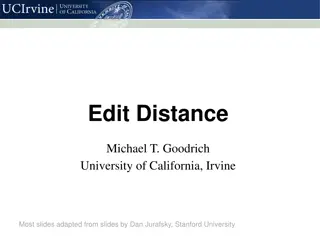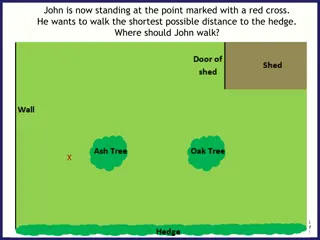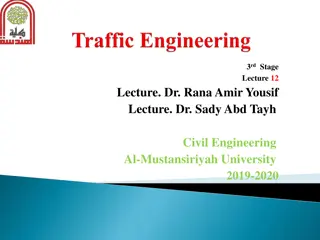
Training Distance Runners - Coaching Lessons and Strategies
Discover the coaching lessons and strategies for training distance runners shared by Derek Leininger, Ph.D. Dive into topics like culture, autonomy, measuring success, peaking strategies, mileage recommendations, long runs, and threshold training.
Download Presentation

Please find below an Image/Link to download the presentation.
The content on the website is provided AS IS for your information and personal use only. It may not be sold, licensed, or shared on other websites without obtaining consent from the author. If you encounter any issues during the download, it is possible that the publisher has removed the file from their server.
You are allowed to download the files provided on this website for personal or commercial use, subject to the condition that they are used lawfully. All files are the property of their respective owners.
The content on the website is provided AS IS for your information and personal use only. It may not be sold, licensed, or shared on other websites without obtaining consent from the author.
E N D
Presentation Transcript
Training Distance Runners Derek Leininger, Ph.D. Fort Wayne, IN Wisconsin Clinic February 2025
My background Athlete and coach -- cross country and 400-3200 in track Cross country -- 3 state qualifying XC teams from an urban high school (Indiana 1 division) Track -- 3:16 4x4 state champs, 7:41 4x8 state runners-up Left coaching in 2015 Currently elementary school principal I am not speaking as an expert -- rather, as a spokesperson for the experts
Coaching lessons (1st half of book) Success takes times / tsunami / culture is tipping point Culture -- personal attention / rituals / transparency Autonomy -- high expectations & views / athlete feedback Role of mentors / strong ties / weak ties / networking Abundance mindset / competition v. cooperation Measuring success -- process over outcome / athlete s experience / your own goals and definitions Failure -- response is key / growth mindset
Approach to Training Tailored To team To individual Forward (7) v. backward (10) Constant evaluation & flexibility
Peaking at the Right Time There is no great secret, except to AVOID tapering (backing way off in mileage) Mental peaking Maintain volume -- higher the distance the more important this is Maintain workout intensity Keep routine, amplify details
Mileage For cross country season Grade Girls Boys Overall, downward trend from 70s-90s 9th 30 36 10th 36 45 Not all-important for many coaches 11th 42 52 Variables age, gender, talent, durability 12th 49 63
Long Runs Pillar workout -- once/week almost year-round 60-70 minutes 18-20% of total weekly volume Pace -- conversational, sometimes pick it up hard the last few miles Very few coaches prescribed running hard for a long run (PAAVO approach)
Threshold Training What s in a name? Tempos, AT, LT, steady state, sustained run Typically 20-35 minutes Variations on pace Time at threshold is key -- Cruise intervals of 1000s or mile repeats Young athletes, early in season, etc.
Interval Training Wait until August / early September to begin Longer to shorter during the season Mile repeats were the highest (some coaches did 2K repeats at threshold pace) 1000-meter repeats were most common in XC season Active recovery, short rest time (less than 1:1)
A Twist on VO2 Intervals Adjustment I made with a group of mid-distance / XC boys Faster 1000-meter repeats through fall season did not equate with faster 5K performances / tendency to sit and kick on last repeat Jack Daniels, Ph.D. -- Quality of VO2 intervals come after 2 minutes in each repetition Keep recovery short so that you are closer to quality on last rep Instead of getting faster in these workouts, run further at same pace (as fitness increases throughout the season) Same volume, slower pace, and MORE high-quality time at max VO2
Traditional vs. Twist TRADITIONAL 6x1000 @ 3:20, 2 min rest 6x1000 @ 3:17, 2 min rest 6x1000 @ 3:15, 2 min rest 6x1000 @ 3:12, 2 min rest Last workout = 6K total @ 16:00 5k pace, 10 min rest, 432 seconds total of high quality (past 2 minutes) TWIST 6x1000 @ 3:20, 2 min rest 6x1100 @ 3:40, 2 min rest 5x1150 @ 3:50, 2 min rest 5x1200 @ 4:00, 2 min rest Last workout = 6K total @ 16:40 5k pace, 8 min rest, 600 seconds of high quality (past 2 minutes)
Training Mistakes/Lessons Oxygen / base training Importance of athlete recovery Athlete buy-in to the training Consistency Patience / hold them back sometimes Individualization
Specific Workouts for 1600 Volume range = 2.5-4k for fast intervals Tried and true = 8-10 x 400 at mile race pace, 1:1 rest Split 900s = 600 @ goal mile pace, 1:00 rest, 300 @ 800 goal pace 3 sets, 4-5 minutes rest 3-4 sets of (2 x 300) = 300 @ 800 race pace, jog 100, 300 @ 800 race pace 4-5 minutes rest between sets (great workout for 800/1600 runners) for different reasons
Specific Workouts for 3200 Always consider oxygen carrying system Volume range = 4-5k for race pace intervals 8 x 600 at 3200 meter race pace, 200 jog recovery anything higher than 600s are really hard to hit race pace (you can try 6 x 800 if you have an aerobic beast of an athlete) 3 x (600-400-300-200) Ladder 200 jog recovery, 2 minutes standing rest between sets 7-10 days out from big race






















